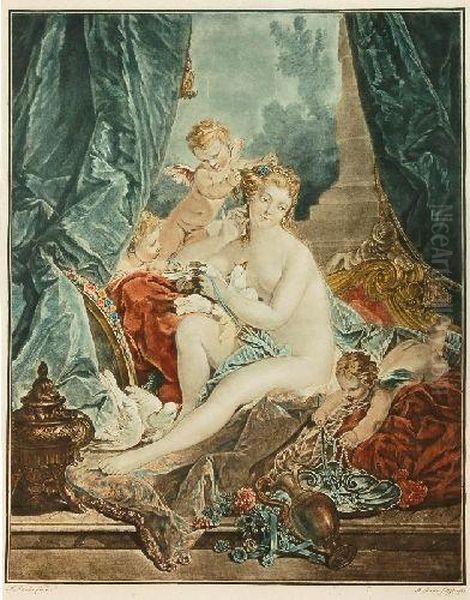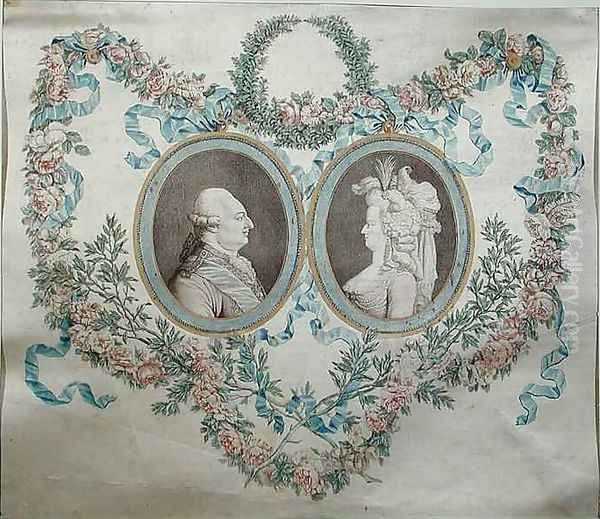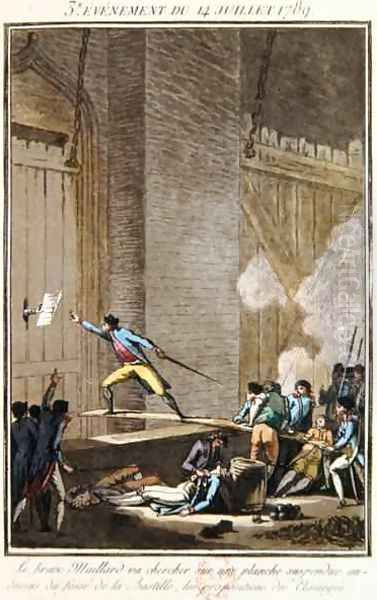Jean-François Janinet, born in Paris in 1752 and deceased in the same city in 1814, stands as a pivotal figure in the history of French printmaking. He was an artist and engraver celebrated particularly for his groundbreaking innovations in color engraving and printing techniques. His mastery allowed for the faithful reproduction of the subtle nuances found in watercolors, pastels, and gouaches, making fine art accessible to a broader audience during a vibrant period of French cultural history. Janinet's contributions were not merely technical; they bridged the gap between original painterly artworks and the burgeoning market for high-quality reproductions, forever influencing the landscape of graphic arts.
Early Life and Artistic Formation
Born into a Parisian environment teeming with artistic activity, Jean-François Janinet's early exposure to the arts likely began within his own family, as it is believed his father was also involved in engraving. This familial introduction would have provided a foundational understanding of the craft. His formal training, however, was significantly shaped under the tutelage of Louis-Marin Bonnet (1736-1793), himself a prominent engraver known for his advancements in crayon-manner and pastel-manner prints.
Under Bonnet, Janinet would have immersed himself in the intricate world of intaglio printmaking, learning various techniques designed to emulate the appearance of drawings and paintings. Bonnet was a key figure in developing multi-plate color printing, and Janinet absorbed these methods, later refining and expanding upon them. Beyond this specialized training, Janinet also enrolled as a painting student at the prestigious Académie Royale de Peinture et de Sculpture. This dual education in both painting and printmaking equipped him with a unique sensibility, allowing him to understand the original artist's intent while possessing the technical prowess to translate it into a printed medium.
Innovations in Color Printmaking: The Aquatint and Multi-Plate Method
Janinet's most significant contributions lie in his sophisticated use and development of color printmaking techniques, particularly those involving aquatint and the multi-plate process. While not the sole inventor of aquatint – a technique that allows for the creation of tonal areas rather than just lines, pioneered by artists like Jean-Baptiste Le Prince (1734-1781) – Janinet was among its most skilled and innovative practitioners, especially in its application to color work.

He perfected a method of using multiple plates, each inked with a different color, to build up a full-color image. This was a complex and labor-intensive process requiring precise registration of each plate to ensure the colors aligned correctly. Janinet's approach often involved a key plate, usually in black or a dark tone, to provide the main outlines and shadows, followed by several other plates for the various hues. This allowed him to achieve remarkable subtlety and a wide range of colors, closely mimicking the delicate washes of watercolor or the soft textures of pastel.
His technique, sometimes referred to as "gravure au lavis en couleurs" (color wash engraving) or "aquarello," was a significant advancement. He was also adept at the "crayon manner" (manière de crayon), which simulated the effect of chalk drawings. By combining these, he could reproduce a variety of artistic styles. His expertise was such that he even authored a treatise, Il Coloristo, detailing the mechanized processes of color printing, further cementing his role as both a practitioner and a theoretician in the field. Other contemporary printmakers exploring color included Philibert-Louis Debucourt (1755-1832), who also excelled in color aquatint, and the Gautier-Dagoty family, known for their color mezzotints.
Reproducing the Masters: A Bridge Between Painting and Public
A substantial part of Janinet's oeuvre consisted of reproductive engravings after the works of prominent contemporary and earlier Rococo painters. His skill in capturing the essence and palette of these artists was unparalleled. He famously reproduced paintings by François Boucher (1703-1770), one of the leading figures of the Rococo style. Janinet's print La Toilette de Vénus (The Toilet of Venus), after Boucher, is a prime example, showcasing his ability to render the soft flesh tones, luxurious fabrics, and mythological charm characteristic of the painter.
Jean-Honoré Fragonard (1732-1806), another luminary of the late Rococo, was also an artist whose works Janinet frequently translated into prints. Pieces like La Folie (Folly) and L'Amour et la Folie (Love and Folly), after Fragonard, demonstrate Janinet's capacity to convey the playful, erotic, and dynamic qualities of Fragonard's compositions through the medium of color aquatint. These prints helped to popularize Fragonard's imagery, making it accessible beyond the elite circles that could afford original paintings.

Janinet also turned his attention to the works of artists known for their charming and often sentimental genre scenes, such as Nicolas Lavreince (1737-1807, whose real name was Niklas Lafrensen) and Pierre-Antoine Baudouin (1723-1769). These artists specialized in "scènes galantes" depicting amorous encounters and fashionable society, and Janinet's prints after their works captured the intimate and decorative qualities that made them so popular. He also engraved works after the celebrated Jean-Antoine Watteau (1684-1721), whose fêtes galantes set the tone for much of 18th-century French art.
His ability to mimic various styles extended to those of miniature painters like Jacques Charlier (c. 1706-1790), whose delicate mythological and erotic scenes found a new life in Janinet's prints. The range of artists whose work he interpreted underscores his versatility and his central role in the dissemination of French artistic taste.
Notable Works and Thematic Range
Beyond the reproductions of Boucher and Fragonard, several other works stand out in Janinet's extensive portfolio. La Mort de Lucretia (The Death of Lucretia), likely after a classical composition, perhaps inspired by painters like Jacques-Louis David (1748-1825) or earlier masters treating this dramatic theme, showcases his ability to handle historical and tragic subjects with gravitas, using color to enhance the emotional impact.
Portraits also formed a part of his output. His print of Marie-Antoinette, after a painting by Jean-Baptiste-André Gautier-Dagoty (1740-1786), is a significant example. Gautier-Dagoty himself was a pioneer in color mezzotint, and Janinet's interpretation of his royal portrait would have been a prestigious commission, reflecting the queen's image to a wider public.
Janinet's thematic range was broad. While known for mythological scenes and gallant subjects, he also produced landscapes, often imbued with a picturesque sensibility popular at the time, perhaps taking inspiration from artists like Hubert Robert (1733-1808) or Claude-Joseph Vernet (1714-1789). His prints also documented contemporary life and historical events. For instance, he created views of Paris and its surroundings, and notably, he produced images related to the French Revolution, such as The King Addresses the Crowd at Versailles, capturing pivotal moments of this tumultuous period. These works served as visual records, akin to early photojournalism, disseminating news and shaping public perception.
One of his most charming series was Costumes et Annales des Grands Théâtres de Paris, which depicted actors and scenes from the Parisian stage, reflecting the era's vibrant theatrical culture. These prints offer valuable insights into costume, stage design, and performance practices of the late 18th century.
The Ill-Fated Aeronautical Venture

Beyond his artistic endeavors, Janinet harbored a keen interest in the scientific advancements of his day, a characteristic of the Enlightenment era. This fascination led him to a rather notorious public undertaking: an attempt at a hot air balloon flight. In 1784, just a year after the Montgolfier brothers had made their historic first manned ascent, Janinet partnered with the physicist and abbé Laurent-Antoine Miollan to construct their own balloon.
They planned a grand public demonstration in the Luxembourg Gardens in Paris, selling tickets to finance the venture and promising a scientific expedition to study atmospheric conditions at different altitudes. Public anticipation was high. However, on the scheduled day, July 11, 1784, the balloon, named "La Suffisante," failed to inflate properly. After several frustrating hours, and with the crowd growing restless and impatient, the balloon caught fire.
The spectacular failure became a subject of widespread public ridicule. Satirical pamphlets, songs, and caricatures lampooned Janinet and Miollan, mocking their scientific pretensions and the disastrous outcome of their ambitious project. This event, while a setback to his public image in certain circles, highlights Janinet's adventurous spirit and his engagement with the era's scientific fervor, even if this particular venture ended in fiasco. It underscores a multifaceted personality, one not confined solely to the printmaker's studio.
Scientific Interests and Later Career
The balloon incident, though embarrassing, did not entirely extinguish Janinet's scientific curiosity. His work in color printing itself required a deep understanding of chemical processes for preparing plates, mixing inks, and achieving desired color effects. It is documented that his interests extended to chemistry and physics more broadly. Intriguingly, at the time of his death, official records reportedly listed his professions not only as an artist but also as a chemist and an optician, suggesting these were more than mere hobbies.
Throughout the French Revolution and into the Napoleonic era, Janinet continued to produce prints, adapting to changing tastes and political climates. He taught his intricate techniques to other artists, ensuring the continuation of his craft. One notable student was Charles Melchior Descourtis (1753-1820), who became a distinguished color printmaker in his own right, particularly known for his reproductions of works by Jean-Frédéric Schall.
Janinet's later works included illustrations for books and further series of prints. His dedication to the art of color engraving remained steadfast, even as new technologies and artistic styles began to emerge at the turn of the century. He navigated the shifting patronage systems and the disruptions of the revolutionary period, maintaining a productive career until his death in 1814.
Legacy and Collections
Jean-François Janinet's legacy is significant. He was a key figure in the golden age of French color printmaking, elevating the reproductive print to a high art form. His technical innovations allowed for unprecedented fidelity in translating the subtleties of painting into multiple impressions, thereby democratizing art and making the works of celebrated painters accessible to a much wider segment of society. He played a crucial role in disseminating Rococo and early Neoclassical aesthetics.
His prints are valued not only for their technical brilliance and aesthetic appeal but also as important historical documents, reflecting the tastes, fashions, and events of late 18th-century France. His work influenced subsequent generations of printmakers and contributed to the rich tradition of French graphic arts.
Today, Jean-François Janinet's prints are held in the collections of major museums and art institutions around the world. These include:
The Metropolitan Museum of Art, New York
The Louvre Museum, Paris
The Bibliothèque Nationale de France, Paris
The British Museum, London
The Art Institute of Chicago
The Rijksmuseum, Amsterdam
Yale University Art Gallery
The Nelson-Atkins Museum of Art
Scholarly attention to Janinet is found in numerous art historical texts. Works such as French Prints and Pastels, 1600–1945: The Collections of The Nelson-Atkins Museum of Art and Creating French Culture Since 8th Century: Treasures from the Bibliothèque nationale de France discuss his contributions within the broader context of French art. His innovations are often cited in studies of printmaking history, highlighting his mastery of aquatint and multi-plate color processes.
In conclusion, Jean-François Janinet was more than just a skilled craftsman; he was an innovator, an entrepreneur, and a popularizer of art. His dedication to the art of color printing left an indelible mark on the visual culture of his time, and his works continue to be admired for their beauty, technical sophistication, and historical significance. He successfully captured the spirit of a dynamic era, translating its artistic achievements into a medium that could reach and delight a broad public, ensuring that the vibrant colors of 18th-century French art would endure.